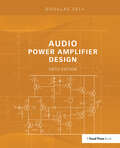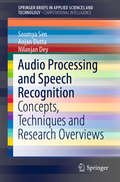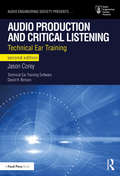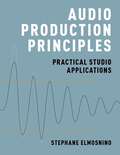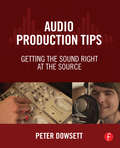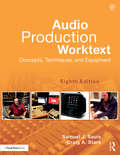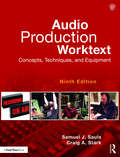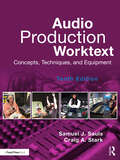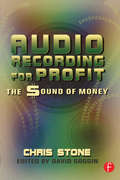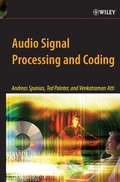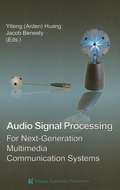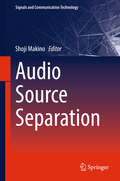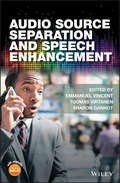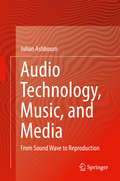- Table View
- List View
Audio Power Amplifier Design
by Douglas SelfThis book is essential for audio power amplifier designers and engineers for one simple reason...it enables you as a professional to develop reliable, high-performance circuits. The Author Douglas Self covers the major issues of distortion and linearity, power supplies, overload, DC-protection and reactive loading. He also tackles unusual forms of compensation and distortion produced by capacitors and fuses. This completely updated fifth edition includes four NEW chapters including one on The XD Principle, invented by the author, and used by Cambridge Audio. Crosstalk, power amplifier input systems, and microcontrollers in amplifiers are also now discussed in this fifth edition, making this book a must-have for audio power amplifier professionals and audiophiles.
Audio Processing and Speech Recognition: Concepts, Techniques and Research Overviews (SpringerBriefs in Applied Sciences and Technology)
by Soumya Sen Anjan Dutta Nilanjan DeyThis book offers an overview of audio processing, including the latest advances in the methodologies used in audio processing and speech recognition. First, it discusses the importance of audio indexing and classical information retrieval problem and presents two major indexing techniques, namely Large Vocabulary Continuous Speech Recognition (LVCSR) and Phonetic Search. It then offers brief insights into the human speech production system and its modeling, which are required to produce artificial speech. It also discusses various components of an automatic speech recognition (ASR) system. Describing the chronological developments in ASR systems, and briefly examining the statistical models used in ASR as well as the related mathematical deductions, the book summarizes a number of state-of-the-art classification techniques and their application in audio/speech classification. By providing insights into various aspects of audio/speech processing and speech recognition, this book appeals a wide audience, from researchers and postgraduate students to those new to the field.
Audio Production and Critical Listening: Technical Ear Training (Audio Engineering Society Presents)
by Jason CoreyAudio Production and Critical Listening: Technical Ear Training, Second Edition develops your critical and expert listening skills, enabling you to listen to audio like an award-winning engineer. Featuring an accessible writing style, this new edition includes information on objective measurements of sound, technical descriptions of signal processing, and their relationships to subjective impressions of sound. It also includes information on hearing conservation, ear plugs, and listening levels, as well as bias in the listening process. The interactive web browser-based "ear training" software practice modules provide experience identifying various types of signal processes and manipulations. Working alongside the clear and detailed explanations in the book, this software completes the learning package that will help you train you ears to listen and really "hear" your recordings. This all-new edition has been updated to include: Audio and psychoacoustic theories to inform and expand your critical listening practice. Access to integrated software that promotes listening skills development through audio examples found in actual recording and production work, listening exercises, and tests. Cutting-edge interactive practice modules created to increase your experience. More examples of sound recordings analysis. New outline for progressing through the EQ ear training software module with listening exercises and tips.
Audio Production and Critical Listening: Technical Ear Training (Audio Engineering Society Presents)
by Jason CoreyAudio Production and Critical Listening: Technical Ear Training, Second Edition develops your critical and expert listening skills, enabling you to listen to audio like an award-winning engineer. Featuring an accessible writing style, this new edition includes information on objective measurements of sound, technical descriptions of signal processing, and their relationships to subjective impressions of sound. It also includes information on hearing conservation, ear plugs, and listening levels, as well as bias in the listening process. The interactive web browser-based "ear training" software practice modules provide experience identifying various types of signal processes and manipulations. Working alongside the clear and detailed explanations in the book, this software completes the learning package that will help you train you ears to listen and really "hear" your recordings. This all-new edition has been updated to include: Audio and psychoacoustic theories to inform and expand your critical listening practice. Access to integrated software that promotes listening skills development through audio examples found in actual recording and production work, listening exercises, and tests. Cutting-edge interactive practice modules created to increase your experience. More examples of sound recordings analysis. New outline for progressing through the EQ ear training software module with listening exercises and tips.
Audio Production Principles: Practical Studio Applications
by Stephane ElmosninoWith this all-in-one manual, students and teachers have an easy-to-read reference that provides a reliable and current rundown of the world of sound production, from planning a recording session to mastering the final product. Organized by four main topics - pre-production, recording various instruments, mixing theories and tools, and mastering - Audio Production Principles follows the actual flow of instruction given over the course of a student's tenure. Chapters address etiquette and basic operations for any recording session written in useful, tutorial style language, providing guidelines for beginner audio engineers on topics including pre-production, equipment selection, and mixing tips by instrument. Jumpstarting the mastering process, lessons delve into features unique to specific tools and techniques. All sections offer instructional scenarios of studio setups, asking students to brainstorm the best production technique for each situation. These exercises also help teachers generate new ideas for instruction and production projects of their own.
AUDIO PRODUCTION PRINCIPLES C: Practical Studio Applications
by Stephane ElmosninoWith this all-in-one manual, students and teachers have an easy-to-read reference that provides a reliable and current rundown of the world of sound production, from planning a recording session to mastering the final product. Organized by four main topics - pre-production, recording various instruments, mixing theories and tools, and mastering - Audio Production Principles follows the actual flow of instruction given over the course of a student's tenure. Chapters address etiquette and basic operations for any recording session written in useful, tutorial style language, providing guidelines for beginner audio engineers on topics including pre-production, equipment selection, and mixing tips by instrument. Jumpstarting the mastering process, lessons delve into features unique to specific tools and techniques. All sections offer instructional scenarios of studio setups, asking students to brainstorm the best production technique for each situation. These exercises also help teachers generate new ideas for instruction and production projects of their own.
Audio Production Tips: Getting the Sound Right at the Source
by Peter DowsettAudio Production Tips: Getting the Sound Right at the Source provides practical and accessible information detailing the production processes for recording today’s bands. By demonstrating how to "get the sound right at the source," author Peter Dowsett lays the appropriate framework to discuss the technical requirements of optimizing the sound of a source. Through its coverage of critical listening, pre-production, arrangement, drum tuning, gain staging and many other areas of music production, Audio Production Tips allows you to build the wide array of skills that apply to the creative process of music production. Broken into two parts, the book first presents foundational concepts followed by more specific production advice on a range of instruments. Key features: Important in-depth coverage of music theory, arrangement and its applications. Real life examples with key references to the author’s music production background. Presents concepts alongside the production of a track captured specifically for the book. A detailed companion website, including audio, video, Pro Tools session files of the track recording process, and videos including accompanying audio that can be examined in the reader’s DAW. Please visit the accompanying companion website, available at www.audioproductiontips.com, for resources that further support the book’s practical approach.
Audio Production Tips: Getting the Sound Right at the Source
by Peter DowsettAudio Production Tips: Getting the Sound Right at the Source provides practical and accessible information detailing the production processes for recording today’s bands. By demonstrating how to "get the sound right at the source," author Peter Dowsett lays the appropriate framework to discuss the technical requirements of optimizing the sound of a source. Through its coverage of critical listening, pre-production, arrangement, drum tuning, gain staging and many other areas of music production, Audio Production Tips allows you to build the wide array of skills that apply to the creative process of music production. Broken into two parts, the book first presents foundational concepts followed by more specific production advice on a range of instruments. Key features: Important in-depth coverage of music theory, arrangement and its applications. Real life examples with key references to the author’s music production background. Presents concepts alongside the production of a track captured specifically for the book. A detailed companion website, including audio, video, Pro Tools session files of the track recording process, and videos including accompanying audio that can be examined in the reader’s DAW. Please visit the accompanying companion website, available at www.audioproductiontips.com, for resources that further support the book’s practical approach.
Audio Production Worktext: Concepts, Techniques, and Equipment
by Samuel J. Sauls Craig A. StarkThis is an excellent introduction to the modern radio production studio, the equipment found in that studio, and the basic techniques needed to accomplish radio production work. The new edition is updated throughout and features new sections on mobile technology, audio editing apps and software, and digital editing, as well as updated graphics and expanded content on portable digital audio players. Features a worktext/website format tailored for both students and teachers, offering a solid foundation for anyone who wishes to know more about radio/audio equipment and production techniques.
Audio Production Worktext: Concepts, Techniques, and Equipment
by Samuel J. Sauls Craig A. StarkThis is an excellent introduction to the modern radio production studio, the equipment found in that studio, and the basic techniques needed to accomplish radio production work. The new edition is updated throughout and features new sections on mobile technology, audio editing apps and software, and digital editing, as well as updated graphics and expanded content on portable digital audio players. Features a worktext/website format tailored for both students and teachers, offering a solid foundation for anyone who wishes to know more about radio/audio equipment and production techniques.
Audio Production Worktext: Concepts, Techniques, and Equipment
by Samuel J. Sauls Craig A. StarkAudio Production Worktext, 9th Edition provides readers the best introduction to audio and radio production. It shows how to navigate modern radio production studios and utilize the latest equipment and software. The 9th edition is updated to cover new mobile technologies, digital consoles, and audio editing apps and software, as well sound for the visual media and Internet radio. The new edition continues to include the worktext/website format tailored for both students and teachers and features like Production Tips that provide notes relevant to various audio production topics, self-study questions and projects, an updated Glossary, and an up-to-date companion website with invaluable student and instructor materials. Included in this edition are offers and features from Pro Sound Effects, FilmTVsound.com, and RadioFX, as well as updated color graphics and images throughout the text.
Audio Production Worktext: Concepts, Techniques, and Equipment
by Samuel J. Sauls Craig A. StarkAudio Production Worktext, 9th Edition provides readers the best introduction to audio and radio production. It shows how to navigate modern radio production studios and utilize the latest equipment and software. The 9th edition is updated to cover new mobile technologies, digital consoles, and audio editing apps and software, as well sound for the visual media and Internet radio. The new edition continues to include the worktext/website format tailored for both students and teachers and features like Production Tips that provide notes relevant to various audio production topics, self-study questions and projects, an updated Glossary, and an up-to-date companion website with invaluable student and instructor materials. Included in this edition are offers and features from Pro Sound Effects, FilmTVsound.com, and RadioFX, as well as updated color graphics and images throughout the text.
Audio Production Worktext: Concepts, Techniques, and Equipment
by Samuel J. Sauls Craig A. StarkNow in its tenth edition, the Audio Production Worktext offers a comprehensive introduction to audio production in radio, television, and film. This hands-on, student-friendly text demonstrates how to navigate modern radio production studios and utilize the latest equipment and software. Key chapters address production planning, the use of microphones, audio consoles, and sound production for the visual media. The reader is shown the reality of audio production both within the studio and on location. New to this edition is material covering podcasting, including online storage and distribution. The new edition also includes an updated glossary and appendix on analog and original digital applications, as well as self-study questions and projects that students can use to further enhance their learning. The accompanying instructor website has been refreshed and includes an instructor’s manual and PowerPoint images. This book remains an essential text for audio and media production students seeking a thorough introduction to the field.
Audio Production Worktext: Concepts, Techniques, and Equipment
by Samuel J. Sauls Craig A. StarkNow in its tenth edition, the Audio Production Worktext offers a comprehensive introduction to audio production in radio, television, and film. This hands-on, student-friendly text demonstrates how to navigate modern radio production studios and utilize the latest equipment and software. Key chapters address production planning, the use of microphones, audio consoles, and sound production for the visual media. The reader is shown the reality of audio production both within the studio and on location. New to this edition is material covering podcasting, including online storage and distribution. The new edition also includes an updated glossary and appendix on analog and original digital applications, as well as self-study questions and projects that students can use to further enhance their learning. The accompanying instructor website has been refreshed and includes an instructor’s manual and PowerPoint images. This book remains an essential text for audio and media production students seeking a thorough introduction to the field.
Audio Recording for Profit: The Sound of Money
by Chris StoneThis book is the first real inside look at the business of professional audio recording, which fuels a multibillion dollar global music industry. Industry pioneer Chris Stone, founder of the legendary Record Plant, provides hard-earned business strategies, guidelines, and advice on every aspect of launching and managing a professional audio recording business. This book is for every audio profit center - from the project studio in the garage to the multi-room diversified recording facility. With 30 years of practical business experience, Mr. Stone reveals the secrets of profitable survival in the pro audio world of today and tomorrow. Why be a player in the professional audio recording industry? What is the attraction and potential payoff? How big an operation are you contemplating? To succeed, one must categorize the various types and sizes of pro audio facilities and their customer bases. It is also essential to understand creative management, marketing, promotion, and the modern economics of pro audio. The professional of tomorrow anticipates recording for new media and is prepared for diversification. All of these issues and more are addressed in this book.
Audio Recording for Profit: The Sound of Money
by Chris StoneThis book is the first real inside look at the business of professional audio recording, which fuels a multibillion dollar global music industry. Industry pioneer Chris Stone, founder of the legendary Record Plant, provides hard-earned business strategies, guidelines, and advice on every aspect of launching and managing a professional audio recording business. This book is for every audio profit center - from the project studio in the garage to the multi-room diversified recording facility. With 30 years of practical business experience, Mr. Stone reveals the secrets of profitable survival in the pro audio world of today and tomorrow. Why be a player in the professional audio recording industry? What is the attraction and potential payoff? How big an operation are you contemplating? To succeed, one must categorize the various types and sizes of pro audio facilities and their customer bases. It is also essential to understand creative management, marketing, promotion, and the modern economics of pro audio. The professional of tomorrow anticipates recording for new media and is prepared for diversification. All of these issues and more are addressed in this book.
Audio Signal Processing and Coding
by Andreas Spanias Ted Painter Venkatraman AttiAn in-depth treatment of algorithms and standards for perceptual coding of high-fidelity audio, this self-contained reference surveys and addresses all aspects of the field. Coverage includes signal processing and perceptual (psychoacoustic) fundamentals, details on relevant research and signal models, details on standardization and applications, and details on performance measures and perceptual measurement systems. It includes a comprehensive bibliography with over 600 references, computer exercises, and MATLAB-based projects for use in EE multimedia, computer science, and DSP courses. An ftp site containing supplementary material such as wave files, MATLAB programs and workspaces for the students to solve some of the numerical problems and computer exercises in the book can be found at ftp://ftp.wiley.com/public/sci_tech_med/audio_signal
Audio Signal Processing for Next-Generation Multimedia Communication Systems
by Jacob Benesty Yiteng Arden HuangAudio Signal Processing for Next-Generation Multimedia Communication Systems presents cutting-edge digital signal processing theory and implementation techniques for problems including speech acquisition and enhancement using microphone arrays, new adaptive filtering algorithms, multichannel acoustic echo cancellation, sound source tracking and separation, audio coding, and realistic sound stage reproduction. This book's focus is almost exclusively on the processing, transmission, and presentation of audio and acoustic signals in multimedia communications for telecollaboration where immersive acoustics will play a great role in the near future.
Audio Source Separation (Signals and Communication Technology)
by Shoji MakinoThis book provides the first comprehensive overview of the fascinating topic of audio source separation based on non-negative matrix factorization, deep neural networks, and sparse component analysis. The first section of the book covers single channel source separation based on non-negative matrix factorization (NMF). After an introduction to the technique, two further chapters describe separation of known sources using non-negative spectrogram factorization, and temporal NMF models. In section two, NMF methods are extended to multi-channel source separation. Section three introduces deep neural network (DNN) techniques, with chapters on multichannel and single channel separation, and a further chapter on DNN based mask estimation for monaural speech separation. In section four, sparse component analysis (SCA) is discussed, with chapters on source separation using audio directional statistics modelling, multi-microphone MMSE-based techniques and diffusion map methods. The book brings together leading researchers to provide tutorial-like and in-depth treatments on major audio source separation topics, with the objective of becoming the definitive source for a comprehensive, authoritative, and accessible treatment. This book is written for graduate students and researchers who are interested in audio source separation techniques based on NMF, DNN and SCA.
Audio Source Separation and Speech Enhancement
by Emmanuel Vincent Tuomas Virtanen Sharon GannotLearn the technology behind hearing aids, Siri, and Echo Audio source separation and speech enhancement aim to extract one or more source signals of interest from an audio recording involving several sound sources. These technologies are among the most studied in audio signal processing today and bear a critical role in the success of hearing aids, hands-free phones, voice command and other noise-robust audio analysis systems, and music post-production software. Research on this topic has followed three convergent paths, starting with sensor array processing, computational auditory scene analysis, and machine learning based approaches such as independent component analysis, respectively. This book is the first one to provide a comprehensive overview by presenting the common foundations and the differences between these techniques in a unified setting. Key features: Consolidated perspective on audio source separation and speech enhancement. Both historical perspective and latest advances in the field, e.g. deep neural networks. Diverse disciplines: array processing, machine learning, and statistical signal processing. Covers the most important techniques for both single-channel and multichannel processing. This book provides both introductory and advanced material suitable for people with basic knowledge of signal processing and machine learning. Thanks to its comprehensiveness, it will help students select a promising research track, researchers leverage the acquired cross-domain knowledge to design improved techniques, and engineers and developers choose the right technology for their target application scenario. It will also be useful for practitioners from other fields (e.g., acoustics, multimedia, phonetics, and musicology) willing to exploit audio source separation or speech enhancement as pre-processing tools for their own needs.
Audio Source Separation and Speech Enhancement
by Emmanuel Vincent Tuomas Virtanen Sharon GannotLearn the technology behind hearing aids, Siri, and Echo Audio source separation and speech enhancement aim to extract one or more source signals of interest from an audio recording involving several sound sources. These technologies are among the most studied in audio signal processing today and bear a critical role in the success of hearing aids, hands-free phones, voice command and other noise-robust audio analysis systems, and music post-production software. Research on this topic has followed three convergent paths, starting with sensor array processing, computational auditory scene analysis, and machine learning based approaches such as independent component analysis, respectively. This book is the first one to provide a comprehensive overview by presenting the common foundations and the differences between these techniques in a unified setting. Key features: Consolidated perspective on audio source separation and speech enhancement. Both historical perspective and latest advances in the field, e.g. deep neural networks. Diverse disciplines: array processing, machine learning, and statistical signal processing. Covers the most important techniques for both single-channel and multichannel processing. This book provides both introductory and advanced material suitable for people with basic knowledge of signal processing and machine learning. Thanks to its comprehensiveness, it will help students select a promising research track, researchers leverage the acquired cross-domain knowledge to design improved techniques, and engineers and developers choose the right technology for their target application scenario. It will also be useful for practitioners from other fields (e.g., acoustics, multimedia, phonetics, and musicology) willing to exploit audio source separation or speech enhancement as pre-processing tools for their own needs.
Audio Technology, Music, and Media: From Sound Wave to Reproduction
by Julian AshbournThis book provides a true A to Z of recorded sound, from its inception to the present day, outlining how technologies, techniques, and social attitudes have changed things, noting what is good and what is less good. The author starts by discussing the physics of sound generation and propagation. He then moves on to outline the history of recorded sound and early techniques and technologies, such as the rise of multi-channel tape recorders and their impact on recorded sound. He goes on to debate live sound versus recorded sound and why there is a difference, particularly with classical music. Other topics covered are the sound of real instruments and how that sound is produced and how to record it; microphone techniques and true stereo sound; digital workstations, sampling, and digital media; and music reproduction in the home and how it has changed. The author wraps up the book by discussing where we should be headed for both popular and classical music recording and reproduction, the role of the Audio Engineer in the 21st century, and a brief look at technology today and where it is headed. This book is ideal for anyone interested in recorded sound. “[Julian Ashbourn] strives for perfection and reaches it through his recordings… His deep knowledge of both technology and music is extensive and it is with great pleasure that I see he is passing this on for the benefit of others. I have no doubt that this book will be highly valued by many in the music industry, as it will be by me.” -- Claudio Di Meo, Composer, Pianist and Principal Conductor of The Kensington Philharmonic Orchestra, The Hemel Symphony Orchestra and The Lumina Choir
Audio Watermark: A Comprehensive Foundation Using MATLAB
by Yiqing Lin Waleed H. AbdullaThis book illustrates the commonly used and novel approaches of audio watermarking for copyrights protection. The author examines the theoretical and practical step by step guide to the topic of data hiding in audio signal such as music, speech, broadcast. The book covers new techniques developed by the authors are fully explained and MATLAB programs, for audio watermarking and audio quality assessments and also discusses methods for objectively predicting the perceptual quality of the watermarked audio signals.Explains the theoretical basics of the commonly used audio watermarking techniquesDiscusses the methods used to objectively and subjectively assess the quality of the audio signalsProvides a comprehensive well tested MATLAB programs that can be used efficiently to watermark any audio media
Audio Wiring Guide: How to wire the most popular audio and video connectors
by John HechtmanWhether you're a pro or an amateur, a musician or into multimedia, you can't afford to guess about audio wiring. The Audio Wiring Guide is a comprehensive, easy-to-use guide that explains exactly what you need to know. No matter the size of your wiring project or installation, this handy tool provides you with the essential information you need and the techniques to use it. Using The Audio Wiring Guide is like having an expert at your side. By following the clear, step-by-step directions, you can do professional-level work at a fraction of the cost. Every step is clearly explained and photo-illustrated. All the common audio connectors are covered as well as most special-use multimedia connectors. It is the perfect guide to keep by your side in the studio or on the road.
Audio Wiring Guide: How to wire the most popular audio and video connectors
by John HechtmanWhether you're a pro or an amateur, a musician or into multimedia, you can't afford to guess about audio wiring. The Audio Wiring Guide is a comprehensive, easy-to-use guide that explains exactly what you need to know. No matter the size of your wiring project or installation, this handy tool provides you with the essential information you need and the techniques to use it. Using The Audio Wiring Guide is like having an expert at your side. By following the clear, step-by-step directions, you can do professional-level work at a fraction of the cost. Every step is clearly explained and photo-illustrated. All the common audio connectors are covered as well as most special-use multimedia connectors. It is the perfect guide to keep by your side in the studio or on the road.
